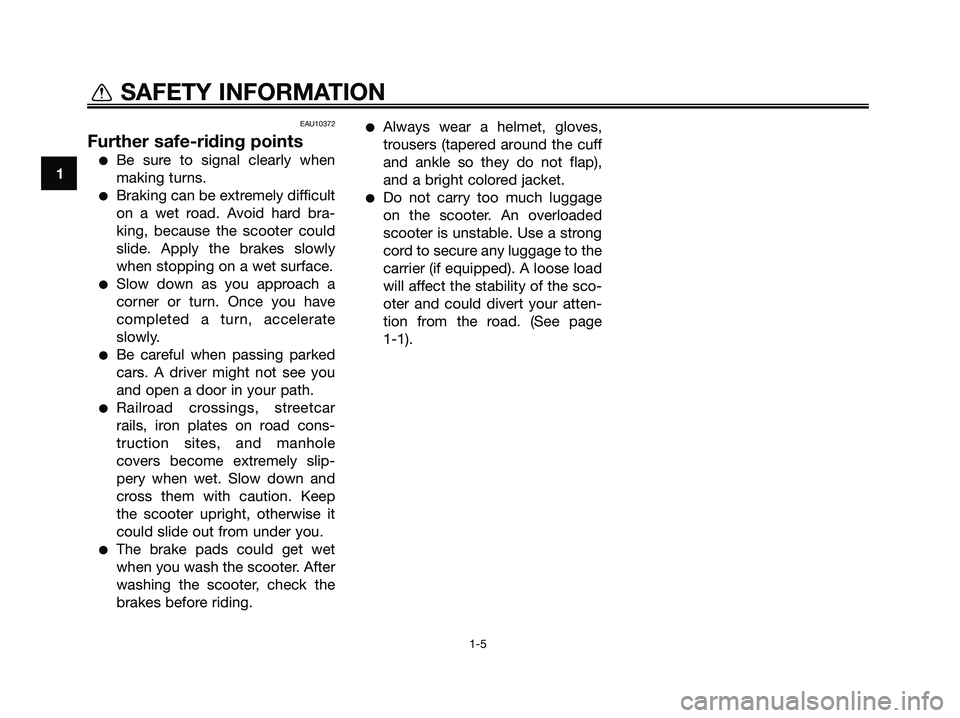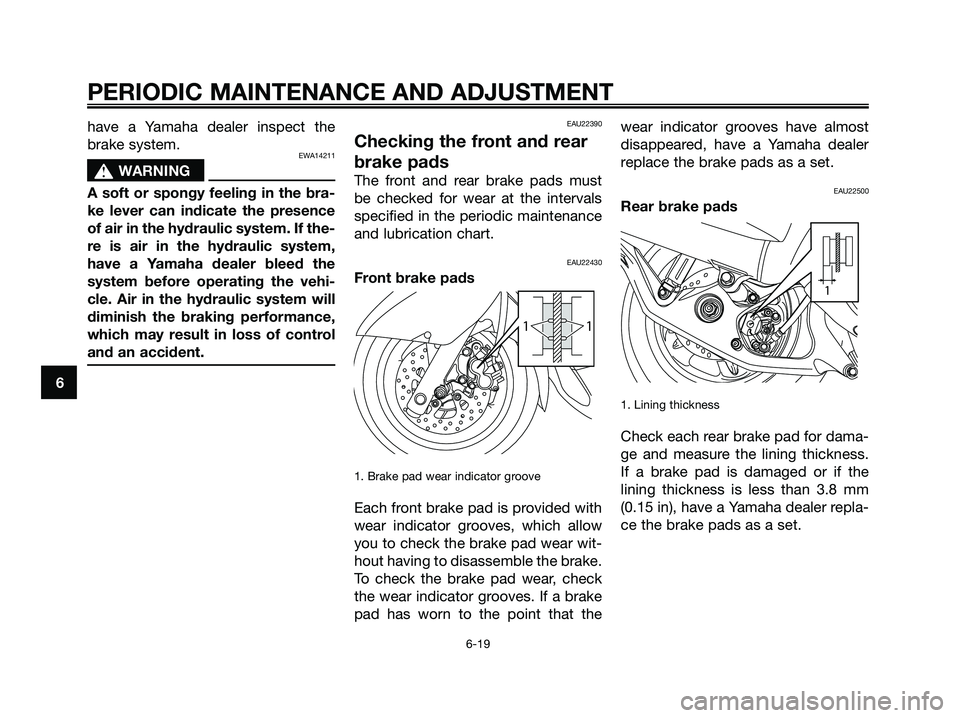2009 YAMAHA MAJESTY 125 brake pads
[x] Cancel search: brake padsPage 6 of 84

SAFETY INFORMATION.....................1-1
Further safe-riding points .................1-5
DESCRIPTION.....................................2-1
Left view ...........................................2-1
Right view .........................................2-2
Controls and instruments .................2-3
INSTRUMENT AND CONTROL
FUNCTIONS........................................3-1
Main switch/steering lock .................3-1
Indicator and warning lights .............3-2
Turn signal indicator lights ...............3-2
High beam indicator light ................3-2
Oil change indicator..........................3-2
Coolant temperature warning light ..3-2
Speedometer unit .............................3-3
Fuel and battery voltage
gauge.............................................3-4
Clock .................................................3-5
Anti-theft alarm (optional) .................3-5
Handlebar switches ..........................3-6
Dimmer switch ..................................3-6
Turn signal switch ............................3-6
Horn switch .....................................3-6
Start switch ......................................3-6
Hazard switch ..................................3-6
Front brake lever...............................3-7
Rear brake lever................................3-7
Fuel tank cap ....................................3-7
Fuel ...................................................3-8Fuel tank breather/overflow hose .....3-9
Catalytic converter..........................3-10
Seat.................................................3-10
Storage compartment.....................3-11
Storage compartment.....................3-12
Adjusting the shock absorber
assemblies...................................3-13
Sidestand ........................................3-13
Ignition circuit cut-off system .........3-14
FOR YOUR SAFETY – PRE-
OPERATION CHECKS........................4-1
Pre-operation check list....................4-2
OPERATION AND IMPORTANT
RIDING POINTS..................................5-1
Starting the engine ...........................5-1
Starting off ........................................5-2
Acceleration and deceleration ..........5-2
Braking..............................................5-3
Tips for reducing fuel
consumption..................................5-3
Engine break-in.................................5-4
Parking ..............................................5-4
PERIODIC MAINTENANCE AND
ADJUSTMENT.....................................6-1
Owner’s tool kit .................................6-1
Periodic maintenance and lubrication
chart ..............................................6-3
Removing and installing panels........6-7Checking the spark plug ..................6-8
Engine oil ..........................................6-9
Final transmission oil ......................6-11
Coolant ...........................................6-12
Air filter and V-belt case
air filter elements .........................6-14
Adjusting the carburetor .................6-15
Adjusting the throttle cable
free play .......................................6-15
Valve clearance ...............................6-16
Tires ................................................6-16
Cast wheels ....................................6-18
Front and rear brake lever
free play .......................................6-18
Checking the front and rear
brake pads ..................................6-19
Checking the brake fluid
level .............................................6-20
Changing the brake fluid ................6-21
Checking and lubricating the
cables ..........................................6-21
Lubricating the front and
rear brake levers..........................6-21
Checking and lubricating the
centerstand and sidestand .........6-22
Checking the front fork ...................6-23
Checking the steering.....................6-23
Checking the wheel bearings .........6-24
Battery ............................................6-24
Replacing the fuses ........................6-26
Replacing a headlight bulb .............6-26
TABLE OF CONTENTS
5D8-F8199-E1.QXD 10/7/08 07:39 Página 6
Page 12 of 84

EAU10372
Further safe-riding points
●Be sure to signal clearly when
making turns.
●Braking can be extremely difficult
on a wet road. Avoid hard bra-
king, because the scooter could
slide. Apply the brakes slowly
when stopping on a wet surface.
●Slow down as you approach a
corner or turn. Once you have
completed a turn, accelerate
slowly.
●Be careful when passing parked
cars. A driver might not see you
and open a door in your path.
●Railroad crossings, streetcar
rails, iron plates on road cons-
truction sites, and manhole
covers become extremely slip-
pery when wet. Slow down and
cross them with caution. Keep
the scooter upright, otherwise it
could slide out from under you.
●The brake pads could get wet
when you wash the scooter. After
washing the scooter, check the
brakes before riding.
●Always wear a helmet, gloves,
trousers (tapered around the cuff
and ankle so they do not flap),
and a bright colored jacket.
●Do not carry too much luggage
on the scooter. An overloaded
scooter is unstable. Use a strong
cord to secure any luggage to the
carrier (if equipped). A loose load
will affect the stability of the sco-
oter and could divert your atten-
tion from the road. (See page
1-1).
1
SAFETY INFORMATION
1-5
5D8-F8199-E1.QXD 10/7/08 07:39 Página 12
Page 13 of 84

EAU10410
Left view
DESCRIPTION
2-1
2
21
3
45 6789
1. Storage compartment (page 3-12)
2. Fuel tank cap (page 3-7)
3. Shock absorber assembly spring preload adjusting ring (page 3-13)
4. Final transmission oil filler cap (page 6-11)
5. Air filter element (page 6-14)6. V-belt case air filter element (page 6-14)
7. Engine oil drain bolt (page 6-9)
8. Sidestand (page 3-13, 6-22)
9. Front brake pads (page 6-19)
5D8-F8199-E1.QXD 10/7/08 07:39 Página 13
Page 14 of 84

EAU10420
Right view
DESCRIPTION
2-2
2
12345
678
1. Grab bar (page 5-2)
2. Owner’s tool kit (page 6-1)
3. Battery (page 6-24)
4. Fuse (page 6-26)5. Coolant reservoir cap (page 6-12)
6. Centerstand (page 6-22)
7. Engine oil filler cap (page 6-9)
8. Rear brake pads (page 6-19)
5D8-F8199-E1.QXD 10/7/08 07:39 Página 14
Page 32 of 84

FOR YOUR SAFETY – PRE-OPERATION CHECKS
4-2
4
EAU15605
Pre-operation check list
ITEM CHECKS PAGE
• Check fuel level in fuel tank.
Fuel• Refuel if necessary.3-8
• Check fuel line for leakage.
• Check oil level in engine.
Engine oil• If necessary, add recommended oil to specified level. 6-9
• Check vehicle for oil leakage.
Final transmission oil• Check vehicle for oil leakage. 6-11
• Check coolant level in reservoir.
Coolant• If necessary, add recommended coolant to specified level. 6-12
• Check cooling system for leakage.
• Check operation.
• If soft or spongy, have Yamaha dealer bleed hydraulic system.
• Check brake pads for wear.
Front brake• Replace if necessary. 6-18 , 6-19, 6-20, 6-21
• Check fluid level in reservoir.
• If necessary, add recommended brake fluid to specified level.
• Check hydraulic system for leakage.
• Check operation.
• If soft or spongy, have Yamaha dealer bleed hydraulic system.
• Check brake pads for wear.
Rear brake• Replace if necessary. 6-18, 6-19, 6-20, 6-21
• Check fluid level in reservoir.
• If necessary, add recommended brake fluid to specified level.
• Check hydraulic system for leakage.
• Make sure that operation is smooth.
Throttle grip• Check cable free play. 6-15
• If necessary, have Yamaha dealer adjust cable free play
and lubricate cable and grip housing.
• Check for damage.
Wheels and tires• Check tire condition and tread depth. 6-16, 6-18
• Check air pressure.
• Correct if necessary.
5D8-F8199-E1.QXD 10/7/08 07:39 Página 32
Page 41 of 84

PERIODIC MAINTENANCE AND ADJUSTMENT
6-4
6
ODOMETER READING
CHECK OR ANNUAL
NO. ITEM MAINTENANCE JOB
1000 km 6000 km 12000 km 18000 km 24000 kmCHECK
(600 mi) (3500 mi) (7000 mi) (10500 mi) (14000 mi)
• Check operation, fluid level and
√√ √√ √ √
7*Front brakevehicle for fluid leakage.
• Replace brake pads. Whenever worn to the limit
• Check operation, fluid level and
√√ √√ √ √
8*Rear brakevehicle for fluid leakage.
• Replace brake pads. Whenever worn to the limit
9*Brake hoses• Check for cracks or damage.√√√ √√• Replace. Every 4 years
10 *Wheels• Check runout and for damage.√√√ √
• Check tread depth and for damage.
11 *Tires• Replace if necessary.
√√√ √√
• Check air pressure.
• Correct if necessary.
12 *Wheel bearings• Check bearing for looseness
√√√ √
or damage.
• Check bearing play and steering
13 *Steering bearingsfor roughness.√√ √√ √
• Lubricate with lithium-soap-
based grease.Every 24000 km (14000 mi)
14 *Chassis fasteners• Make sure that all nuts, bolts and
screws are properly tightened.√√√ √√
15Sidestand, • Check operation.
centerstand• Lubricate.√√√ √√
16 *Sidestand
switch• Check operation.√√ √√ √ √
17 *Front fork• Check operation and for oil
√√√ √
leakage.
5D8-F8199-E1.QXD 10/7/08 07:39 Página 41
Page 56 of 84

have a Yamaha dealer inspect the
brake system.
EWA14211
s s
WARNING
A soft or spongy feeling in the bra-
ke lever can indicate the presence
of air in the hydraulic system. If the-
re is air in the hydraulic system,
have a Yamaha dealer bleed the
system before operating the vehi-
cle. Air in the hydraulic system will
diminish the braking performance,
which may result in loss of control
and an accident.
EAU22390
Checking the front and rear
brake pads
The front and rear brake pads must
be checked for wear at the intervals
specified in the periodic maintenance
and lubrication chart.
EAU22430
Front brake pads
1. Brake pad wear indicator groove
Each front brake pad is provided with
wear indicator grooves, which allow
you to check the brake pad wear wit-
hout having to disassemble the brake.
To check the brake pad wear, check
the wear indicator grooves. If a brake
pad has worn to the point that thewear indicator grooves have almost
disappeared, have a Yamaha dealer
replace the brake pads as a set.
EAU22500
Rear brake pads
1. Lining thickness
Check each rear brake pad for dama-
ge and measure the lining thickness.
If a brake pad is damaged or if the
lining thickness is less than 3.8 mm
(0.15 in), have a Yamaha dealer repla-
ce the brake pads as a set.
1
11
PERIODIC MAINTENANCE AND ADJUSTMENT
6-19
6
5D8-F8199-E1.QXD 10/7/08 07:39 Página 56
Page 57 of 84

EAU22580
Checking the brake fluid
level
Front brake
1. Minimum level mark
Rear brake
1. Minimum level mark
Insufficient brake fluid may allow air
to enter the brake system, possibly
causing it to become ineffective.
Before riding, check that the brake
fluid is above the minimum level mark
and replenish if necessary. A low bra-
ke fluid level may indicate worn brake
pads and/or brake system leakage. If
the brake fluid level is low, be sure to
check the brake pads for wear and
the brake system for leakage.
Observe these precautions:
●When checking the fluid level,
make sure that the top of the bra-
ke fluid reservoir is level.
●Use only the recommended qua-
lity brake fluid, otherwise the rub-
ber seals may deteriorate, cau-
sing leakage and poor braking
performance.
●Refill with the same type of brake
fluid. Mixing fluids may result in a
harmful chemical reaction and
lead to poor braking performan-
ce.
●Be careful that water does not
enter the brake fluid reservoir
when refilling. Water will signifi-
cantly lower the boiling point of
the fluid and may result in vapor
lock.
●Brake fluid may deteriorate pain-
ted surfaces or plastic parts.
Always clean up spilled fluid
immediately.
●As the brake pads wear, it is nor-
mal for the brake fluid level to
gradually go down. However, if
the brake fluid level goes down
suddenly, have a Yamaha dealer
check the cause.
Recommended brake fluid:
DOT 4MIN1
MIN1
PERIODIC MAINTENANCE AND ADJUSTMENT
6-20
6
5D8-F8199-E1.QXD 10/7/08 07:39 Página 57